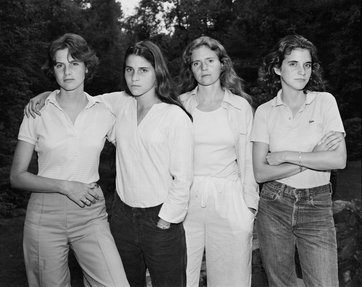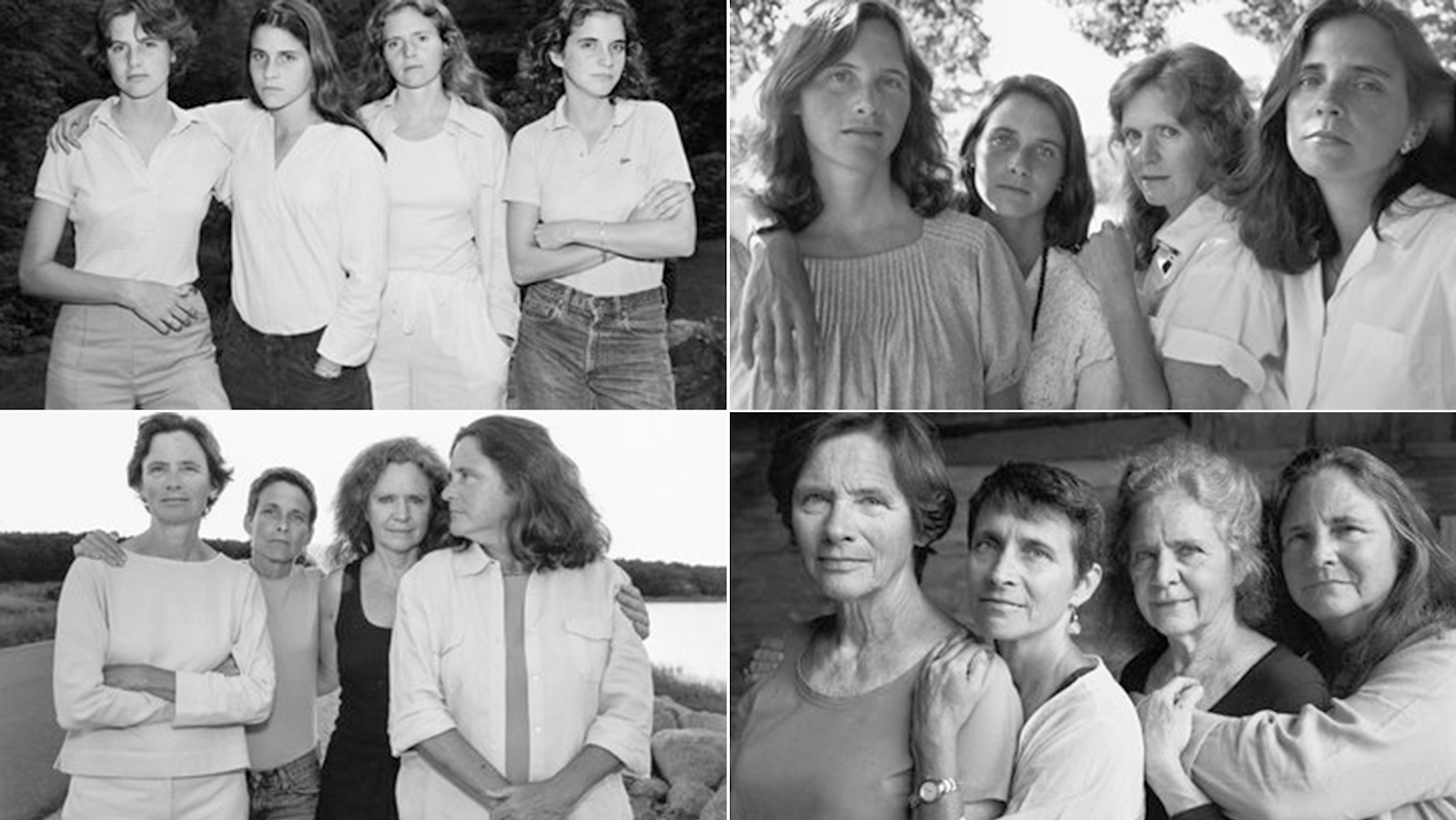In 1975, photographer Nicholas Nixon captured a seemingly ordinary moment that would evolve into an extraordinary chronicle of time, family, and the human experience. During a family gathering in Massachusetts, Nixon, known for his compelling black-and-white portraits, took a photograph of his wife, Bebe, alongside her three sisters: Heather, Mimi, and Laurie. Unbeknownst to them, this spontaneous act would spark a project spanning four decades, culminating in a series that has captivated audiences worldwide.
The initial photograph was unplanned. Nixon, intrigued by the sisters' dynamic as they stood together, asked if he could take their picture. They agreed, and the resulting image portrayed four young women, aged between 15 and 25, standing in a line. This simple composition resonated with Nixon, who saw in it a profound representation of familial bonds and the passage of time.
The following year, at Laurie's college graduation, Nixon suggested they recreate the photograph, positioning themselves in the same order: Heather, Mimi, Bebe, and Laurie. The sisters obliged, and upon developing the film, Nixon noticed subtle yet significant changes—their expressions, postures, and the nuances of their interactions had evolved. This observation led to a proposal: to capture this portrait annually, creating a visual time capsule of their lives.
Thus began a remarkable tradition. Each year, the sisters would gather, standing in the same order, and Nixon would photograph them using his 8x10 large-format camera. This choice of equipment was deliberate; the large negatives produced images of exceptional clarity and detail, allowing viewers to observe the minutiae of aging and the deepening of relationships over time.
Initially, the annual photographs were a private endeavor, a personal ritual for the family. However, as the collection grew, its significance became apparent. The series, known as "The Brown Sisters," was first exhibited publicly in 1999, 24 years after the inaugural photograph. The reception was profound; audiences were moved by the authenticity and intimacy of the images, which offered an unvarnished look at the passage of time and the enduring nature of sisterhood.
Over the years, the series has been displayed in prestigious institutions, including the Museum of Modern Art in New York and the National Gallery of Art in Washington, D.C. Critics and viewers alike have lauded its depth and simplicity. The photographs, devoid of elaborate settings or props, focus solely on the sisters, highlighting their evolving relationships and individual journeys.
One of the most compelling aspects of the series is its ability to convey universal themes through a specific lens. While the photographs depict the Brown sisters, they resonate with anyone who has experienced the passage of time, the complexities of family relationships, and the process of aging. The images serve as a mirror, reflecting our own experiences and emotions.
As the years progressed, the sisters' appearances changed—they aged, their styles evolved, and their expressions shifted. Yet, certain elements remained constant: their formation, their closeness, and the annual commitment to this project. This blend of change and continuity offers a poignant commentary on life's transient yet enduring nature.
The series also highlights the role of the photographer as both an observer and a participant. Nixon, initially an outsider documenting the sisters, became an integral part of the narrative. His relationship with the subjects added layers of depth to the images, capturing not just the physical changes but also the emotional and relational dynamics that unfolded over four decades.
In 2014, to commemorate the 40th anniversary of the project, a comprehensive collection titled "Nicholas Nixon: The Brown Sisters. Forty Years." was published. This compilation features all 40 portraits, offering a seamless narrative of the sisters' journey through time. The book has been praised for its candid portrayal of aging and the strength of familial bonds.
The impact of "The Brown Sisters" extends beyond the art world. It has sparked discussions on topics such as the representation of women, the concept of beauty across ages, and the societal perceptions of aging. The series challenges viewers to confront their own feelings about these issues, encouraging a deeper appreciation for the natural progression of life.
In conclusion, Nicholas Nixon's "The Brown Sisters" is more than a collection of photographs; it is a testament to the power of consistency, the beauty of aging, and the unbreakable bonds of family. Through this series, Nixon has created a timeless narrative that continues to inspire, move, and provoke thought, reminding us all of the shared human experience encapsulated in the passage of time.
As the years passed, the project that had begun as a spontaneous photograph became an annual tradition, something the four sisters came to anticipate each year. What started as a casual request turned into a 40-year journey of life, love, change, and togetherness.
At first, it was easy. The sisters were young, full of energy, and their lives were filled with promise. Each year, when Nixon lined them up in the same order—Heather, Mimi, Bebe, and Laurie—they would smile and pose, not thinking much about what this project would eventually mean.
But as time went on, things changed.
Their smiles grew softer, their expressions more thoughtful. Lines began to appear around their eyes, their faces became more defined. Aging was no longer something distant—it was happening before their eyes.
Each year, Nixon would print the latest photo alongside the previous ones, and the sisters would gather to look at them, noticing the small but inevitable changes. At first, they laughed.
“Look at my hair in this one!”
“I was so thin back then!”
“Oh no, why did I wear that?”
But as the years continued, the photos became something else entirely—a reflection of the passage of time, a documentation of a journey they were all taking together.
It was no longer about the way they looked. It was about who they were becoming.
By the time the project reached its 25th year, it had already gained widespread recognition. Art critics and photographers marveled at Nixon’s ability to capture something so deeply human in a way that no staged portrait ever could.
Unlike traditional portrait photography, which often focuses on highlighting beauty, these images embraced the natural process of aging.
The sisters didn’t use makeup or attempt to hide their age. They stood in front of the camera exactly as they were—with every line, every wrinkle, every bit of wisdom etched into their faces.
The images were displayed in some of the most prestigious galleries in the world, including:
The Museum of Modern Art (MoMA) in New York
The San Francisco Museum of Modern Art
The National Gallery of Art in Washington, D.C.
People stood in front of the photographs for hours, mesmerized by the transformation. They weren’t just looking at four women—they were looking at themselves.
Because that’s what made the series so powerful. It wasn’t just about these four sisters.
It was about all of us.
It forced viewers to confront their own relationship with time.
It asked questions that many people are afraid to answer:
How do I feel about getting older?
Do I embrace it, or do I fight against it?
What will I look like in 40 years?
Will I still be standing beside the people I love?
Though each photograph was a portrait of time, it was also a portrait of love.
The relationship between the four sisters evolved in ways even they hadn’t expected.
In the early photographs, they stood slightly apart—each one still a little independent, still finding her own way in the world.
But as the decades passed, their bodies moved closer together.
A hand on a shoulder.
An arm wrapped around a waist.
A small lean into one another.
The change was subtle, but powerful.
Over the years, they had become each other’s anchors. They had faced marriages, divorces, births, deaths, and the struggles of life. But through it all, they stood together—literally and figuratively.
In one of the later photographs, a viewer at an exhibition pointed out something profound:
“They’re not just standing next to each other. They’re holding each other up.”
And that was the true magic of the project.
It wasn’t just about watching time move forward.
It was about watching love remain constant.
By the time the 40th year arrived, the sisters knew that this would be the final photograph.
The project could have continued—but something about reaching four decades felt right.
When they stood together for the last time in front of Nixon’s camera, there was something different in the air.
This time, there were no playful comments about hair or clothing.
This time, they knew exactly what this meant.
They weren’t just taking another picture.
They were capturing the end of an era.
When Nixon developed the last photograph, everyone who saw it was moved to tears.
Not because it was sad, but because it was beautiful.
By then, the sisters were older, wiser, softer. Their faces carried not just age, but experience—the weight of everything they had been through together.
But most of all, what made the final image so emotional was something no one expected:
Mimi’s expression.
Throughout the project, Mimi had always been the serious one. In the early photos, she often looked stern, a little guarded, as if she was holding something back.
But in the last photo, something changed.
She wasn’t just standing there—she was smiling.
It wasn’t a forced or performative smile. It was real.
It was the smile of someone who had finally let go of something they had been holding on to for a long time.
It was the smile of someone who understood the beauty of what they had created.
For many people who viewed the series, that single moment—Mimi’s transformation over 40 years—was the most emotional part of all.
It showed that people don’t just age. They grow.
They change.
They learn to love themselves, love others, and accept the passage of time for what it is—something uncontrollable, but profoundly beautiful.
Though the project ended, its impact continues to this day.
Photographers, artists, and everyday people still study The Brown Sisters to understand what it means to document life in its most honest form.
It has been used in:
Psychology courses to discuss aging and memory.
Photography schools to teach the power of simplicity.
Feminist studies to challenge societal norms around beauty and aging.
But more than anything, it has touched the hearts of people all over the world.
It reminds us to cherish time.
It reminds us to embrace change.
It reminds us to hold our loved ones close—because nothing lasts forever.
In one interview, Nixon was asked why he thought the project resonated so deeply with people.
His answer was simple:
“Because we all know what it feels like to watch time slip away.”
If you had the opportunity to do something like this with your family, would you?
Would you be willing to document your life every year, watching yourself and your loved ones change?
Would you be brave enough to face the truth of time?
That’s the true gift of "The Brown Sisters."
It shows us that life moves forward whether we like it or not.
But it also shows us that if we hold on to each other, we’ll never be alone on the journey.
What started as a simple photograph in 1975 became one of the most powerful artistic projects in history.
It wasn’t about fame, or beauty, or perfection.
It was about love, memory, and the human experience.
And at the end of the day, isn’t that what life is all about?












0 commentaires: